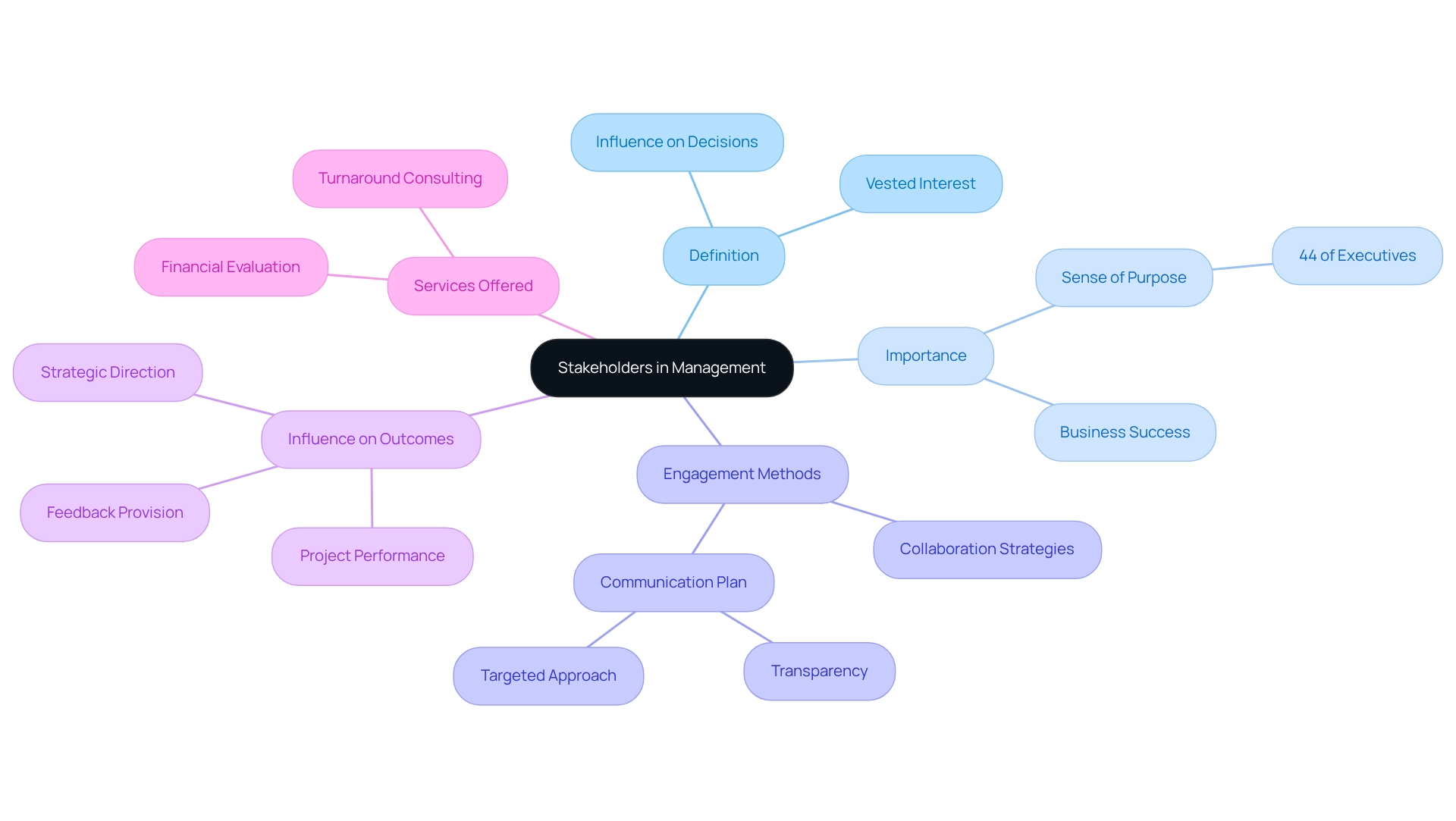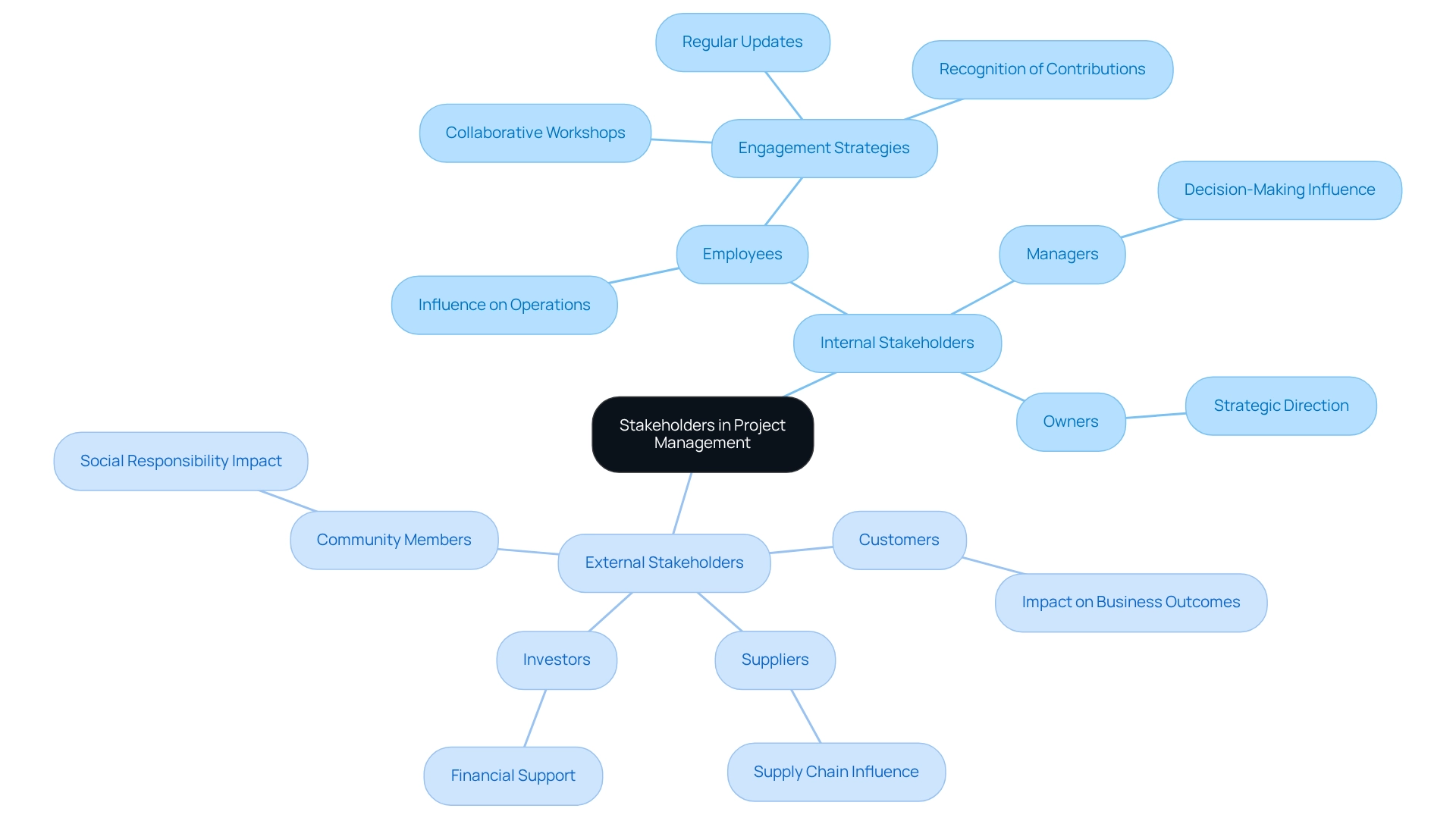Overview
This article emphasizes the critical importance of understanding the definition of stakeholders in management for developing effective strategies that drive business success. Recognizing the roles and influences of both internal and external stakeholders, along with implementing tailored engagement strategies, can significantly enhance project outcomes and promote sustainable growth. This assertion is supported by compelling case studies and statistics on engagement and productivity.
Introduction
In the intricate web of business dynamics, stakeholders play a pivotal role in determining the fate of projects and organizations. These individuals, groups, or entities hold a vested interest in outcomes, and their influence can either propel initiatives forward or hinder progress. As companies navigate the complexities of restructuring and turnaround strategies, understanding the diverse landscape of stakeholders becomes crucial.
From internal team members to external partners, each group presents unique challenges and opportunities that can shape strategic direction. This article delves into the core concepts of stakeholder management, identifies key types, and outlines effective engagement strategies that ensure all voices are heard and aligned with organizational goals.
Ultimately, these strategies drive success in an ever-evolving business environment.
Define Stakeholders: Core Concepts and Importance
The stakeholder definition in management refers to individuals, groups, or organizations that have a vested interest in the success or failure of a business or project. Their influence can significantly shape the outcomes of decisions made within the organization. Acknowledging the significance of involved parties is crucial, particularly in restructuring situations where their needs and concerns must be addressed. For instance, a well-implemented engagement approach can yield enhanced restructuring results, as illustrated by a case study on creating a communication plan that effectively addressed various levels of involvement. This method not only improves clarity but also fosters a cooperative atmosphere that aids in achieving goals.
In 2025, the importance of involved parties in business success is underscored by the fact that 44 percent of executives indicate their organizations are cultivating a robust sense of purpose, aligning with the expectations of those involved. Effective management approaches that align with the stakeholder definition in management are vital in turnaround scenarios, as they empower teams to make informed choices and achieve significant results. As Emmanuel Acquah aptly notes, aligning the needs of interested parties with initiative objectives is essential for promoting collaboration.
Moreover, interested parties influence initiative outcomes in numerous ways, from providing crucial feedback to shaping strategic direction. Their involvement can lead to improved project performance and sustainable growth, making it essential for organizations to prioritize relationships in their management strategies. Transform Your Small/Medium Business offers services like turnaround consulting and financial evaluation, aimed at assisting involved parties during the turnaround process. By utilizing these services, companies can ensure that the requirements of interested parties are met, ultimately facilitating a successful recovery.

Identify Types of Stakeholders: Internal vs. External
Stakeholder definition in management categorizes stakeholders in project management into two primary groups: internal and external. Internal participants, including employees, managers, and owners, play a direct role in the organization, significantly influencing daily operations and decision-making processes. In contrast, external parties—such as customers, suppliers, investors, and community members—are affected by the organization's actions and results, despite not being directly involved in its operations.
Comprehending these distinctions is crucial for developing effective communication and interaction strategies tailored to the unique needs and expectations of each group. For instance, statistics indicate that companies with highly engaged workforces are 17% more productive than those with lower levels of involvement. This underscores the importance of internal participant engagement, which can be fostered through regular updates, collaborative workshops, and recognition of employee contributions. Moreover, the average knowledge worker spends 2.5 hours daily seeking information, highlighting the necessity for efficient internal communication to enhance involvement.
As we look towards 2025, the landscape of participant interaction continues to evolve, with a significant emphasis on internal participants. A considerable number of companies are now prioritizing interaction strategies that not only enhance productivity but also increase profitability. Case studies reveal that organizations with high employee engagement experience 21% greater profitability, reinforcing the notion that stakeholder involvement transcends human resources; it is a critical component of overall business strategy. By recognizing and addressing the distinct roles of internal and external parties as outlined in the stakeholder definition in management, organizations can navigate challenges more effectively and leverage opportunities for sustainable growth.

Conduct Stakeholder Analysis: Steps and Techniques
Conducting a comprehensive analysis of interested parties is essential for the effective management of initiatives as it aligns with the stakeholder definition in management. The following key steps must be adhered to:
- Identify Stakeholders: Compile a thorough list of all individuals, groups, or organizations that possess a vested interest in the project.
- Assess Influence and Interest: Evaluate each participant's level of influence alongside their interest in the initiative's outcomes. This assessment is vital for understanding their potential impact on the project.
- Prioritize Interested Parties: Employ tools such as the Power/Interest Grid to categorize individuals based on their influence and interest levels. This prioritization is crucial, enabling managers to focus their efforts on the most influential stakeholders.
- Develop Engagement Strategies: Formulate tailored communication and engagement strategies for each interest group according to their position in the grid. Effectively involving interested parties, in line with the stakeholder definition in management, ensures their concerns are acknowledged, fostering a collaborative environment. This structured approach not only aids in managing expectations but also enhances successful outcomes. For instance, in crisis management scenarios, clearly defining goals and maintaining consistent communication can significantly mitigate unrealistic expectations among involved parties. By transparently sharing relevant information, managers can also convert low power, low interest individuals into more engaged participants, ultimately leading to improved results.
Develop Stakeholder Engagement Strategies: Best Practices
To cultivate effective engagement strategies with interested parties, consider the following best practices:
- Communicate Regularly: Establish a consistent communication schedule to keep interested parties informed about project developments. Regular updates significantly enhance trust and transparency, which are crucial during times of crisis, especially when quick decision-making is essential for business turnaround.
- Listen Actively: Encourage feedback and be responsive to concerns from involved parties. Active listening fosters trust and rapport, essential for maintaining strong relationships, particularly in financial restructuring scenarios where real-time analytics can guide decisions.
- Tailor Engagement: Customize your engagement approach based on each party's influence and interest levels. This focused approach guarantees that communication is pertinent and influential, aligning with the expectations of involved parties and organizational objectives. Understanding the roles and interests of key participants, as indicated by the stakeholder definition in management, can enhance cooperation and efficiency.
- Engage Interested Parties in Decision-Making: Where suitable, incorporate interested parties in discussions and choices. This involvement fosters a sense of ownership and commitment, which can be particularly beneficial in navigating complex financial landscapes. Streamlined decision-making processes can help preserve business health during challenging times.
- Monitor and Adapt: Continuously assess the effectiveness of your engagement strategies. Be willing to adapt them as necessary to respond to evolving situations and the requirements of interested parties. Employing real-time business analytics and the client dashboard can result in better outcomes and stronger relationships with involved parties, ensuring that lessons learned from the turnaround process are operationalized effectively.
Adopting these practices can significantly enhance relationships with involved parties and contribute to the overall success of projects, especially in challenging environments like financial restructuring. Additionally, the stakeholder definition in management highlights the importance of aligning stakeholders' expectations with organizational goals for success.
Conclusion
Understanding and effectively managing stakeholders is paramount for any organization aiming for success, particularly during restructuring and turnaround phases. Stakeholders, whether internal or external, significantly influence project outcomes, and their engagement can lead to enhanced performance and sustainable growth. By recognizing the distinct roles of various stakeholders, organizations can tailor their communication and engagement strategies to meet diverse needs, ultimately fostering a collaborative environment that supports project objectives.
The process of stakeholder analysis is a critical step in this journey. By identifying stakeholders, assessing their influence and interest, prioritizing their needs, and developing targeted engagement strategies, organizations can navigate challenges more effectively. Best practices such as regular communication, active listening, tailored engagement, and involving stakeholders in decision-making play a vital role in building trust and ensuring alignment with organizational goals.
In an ever-evolving business landscape, the importance of stakeholder management cannot be overstated. By prioritizing stakeholder relationships and adapting strategies to meet their expectations, organizations can not only drive successful outcomes but also create a resilient foundation for future endeavors. Embracing these principles will empower businesses to thrive, turning challenges into opportunities in their pursuit of success.
Frequently Asked Questions
What are stakeholders in management?
Stakeholders are individuals, groups, or organizations that have a vested interest in the success or failure of a business or project. Their influence can significantly shape organizational decisions and outcomes.
Why is it important to acknowledge stakeholders?
Acknowledging stakeholders is crucial, especially during restructuring situations, as their needs and concerns must be addressed to improve outcomes. A well-implemented engagement approach can enhance restructuring results and foster a cooperative atmosphere.
How can stakeholder engagement impact restructuring?
Effective stakeholder engagement can lead to improved clarity and collaboration, which aids in achieving goals during restructuring processes. For example, creating a communication plan that addresses various levels of involvement can yield better results.
What percentage of executives believe in cultivating a sense of purpose aligned with stakeholders?
In 2025, 44 percent of executives indicated that their organizations are cultivating a robust sense of purpose that aligns with the expectations of stakeholders.
How do stakeholders influence initiative outcomes?
Stakeholders influence initiative outcomes by providing crucial feedback, shaping strategic direction, and improving project performance, which can lead to sustainable growth.
What services does Transform Your Small/Medium Business offer?
Transform Your Small/Medium Business offers services like turnaround consulting and financial evaluation to assist involved parties during the turnaround process, ensuring that their requirements are met for a successful recovery.




